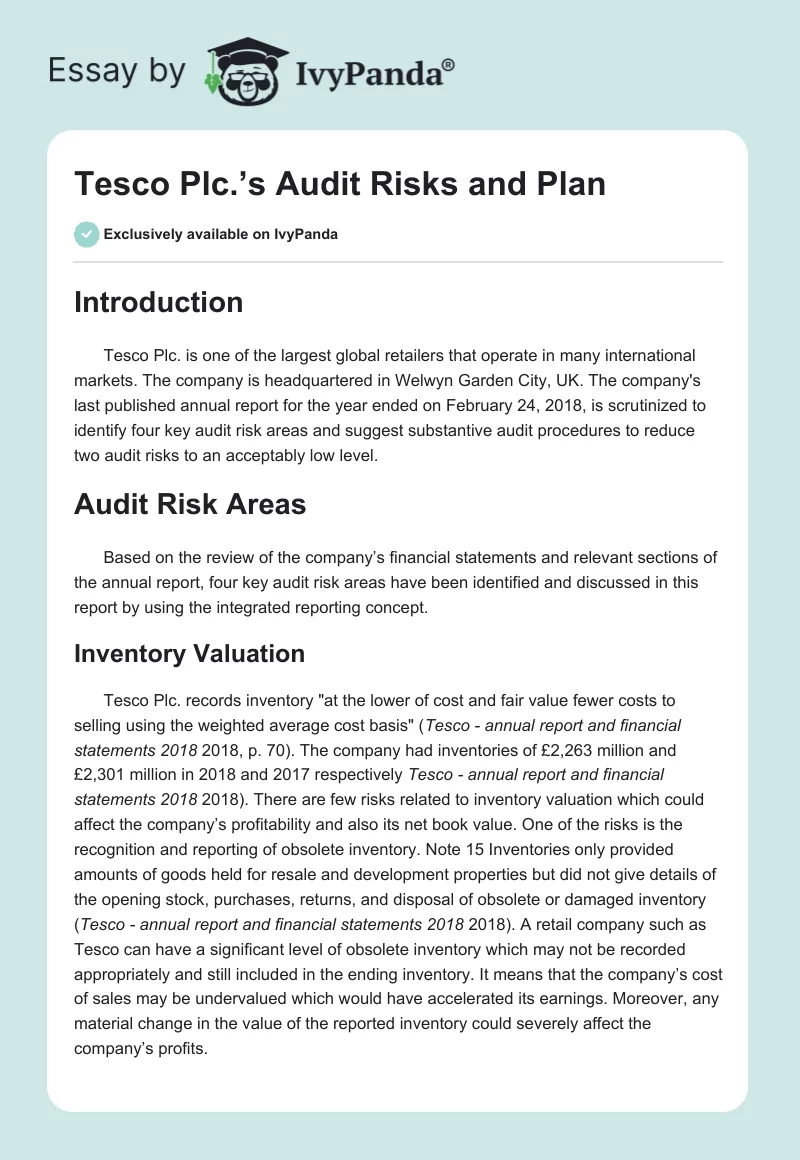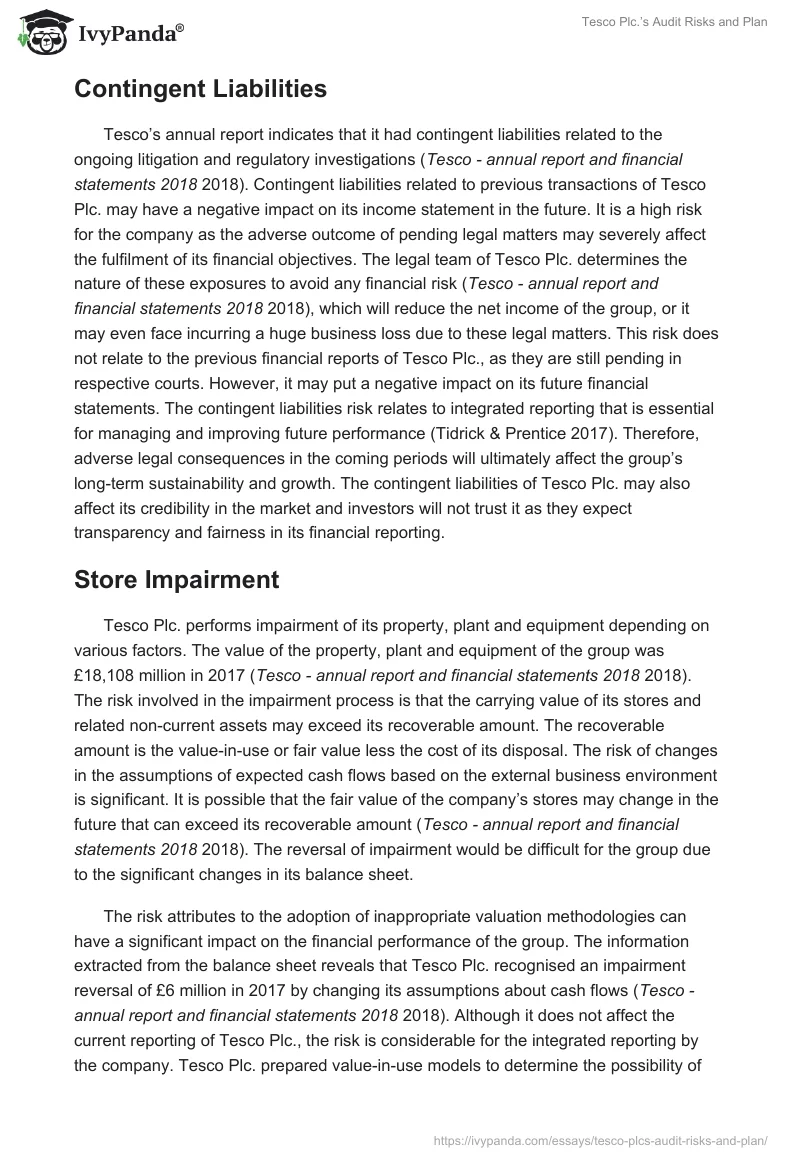Introduction
Tesco Plc. is one of the largest global retailers that operate in many international markets. The company is headquartered in Welwyn Garden City, UK. The company’s last published annual report for the year ended on February 24, 2018, is scrutinized to identify four key audit risk areas and suggest substantive audit procedures to reduce two audit risks to an acceptably low level.
Audit Risk Areas
Based on the review of the company’s financial statements and relevant sections of the annual report, four key audit risk areas have been identified and discussed in this report by using the integrated reporting concept.
Inventory Valuation
Tesco Plc. records inventory “at the lower of cost and fair value fewer costs to selling using the weighted average cost basis” (Tesco – annual report and financial statements 2018 2018, p. 70). The company had inventories of £2,263 million and £2,301 million in 2018 and 2017 respectively Tesco – annual report and financial statements 2018 2018). There are few risks related to inventory valuation which could affect the company’s profitability and also its net book value. One of the risks is the recognition and reporting of obsolete inventory. Note 15 Inventories only provided amounts of goods held for resale and development properties but did not give details of the opening stock, purchases, returns, and disposal of obsolete or damaged inventory (Tesco – annual report and financial statements 2018 2018). A retail company such as Tesco can have a significant level of obsolete inventory which may not be recorded appropriately and still included in the ending inventory. It means that the company’s cost of sales may be undervalued which would have accelerated its earnings. Moreover, any material change in the value of the reported inventory could severely affect the company’s profits.
Contingent Liabilities
Tesco’s annual report indicates that it had contingent liabilities related to the ongoing litigation and regulatory investigations (Tesco – annual report and financial statements 2018 2018). Contingent liabilities related to previous transactions of Tesco Plc. may have a negative impact on its income statement in the future. It is a high risk for the company as the adverse outcome of pending legal matters may severely affect the fulfilment of its financial objectives. The legal team of Tesco Plc. determines the nature of these exposures to avoid any financial risk (Tesco – annual report and financial statements 2018 2018), which will reduce the net income of the group, or it may even face incurring a huge business loss due to these legal matters. This risk does not relate to the previous financial reports of Tesco Plc., as they are still pending in respective courts. However, it may put a negative impact on its future financial statements. The contingent liabilities risk relates to integrated reporting that is essential for managing and improving future performance (Tidrick & Prentice 2017). Therefore, adverse legal consequences in the coming periods will ultimately affect the group’s long-term sustainability and growth. The contingent liabilities of Tesco Plc. may also affect its credibility in the market and investors will not trust it as they expect transparency and fairness in its financial reporting.
Store Impairment
Tesco Plc. performs impairment of its property, plant and equipment depending on various factors. The value of the property, plant and equipment of the group was £18,108 million in 2017 (Tesco – annual report and financial statements 2018 2018). The risk involved in the impairment process is that the carrying value of its stores and related non-current assets may exceed its recoverable amount. The recoverable amount is the value-in-use or fair value less the cost of its disposal. The risk of changes in the assumptions of expected cash flows based on the external business environment is significant. It is possible that the fair value of the company’s stores may change in the future that can exceed its recoverable amount (Tesco – annual report and financial statements 2018 2018). The reversal of impairment would be difficult for the group due to the significant changes in its balance sheet.
The risk attributes to the adoption of inappropriate valuation methodologies can have a significant impact on the financial performance of the group. The information extracted from the balance sheet reveals that Tesco Plc. recognised an impairment reversal of £6 million in 2017 by changing its assumptions about cash flows (Tesco – annual report and financial statements 2018 2018). Although it does not affect the current reporting of Tesco Plc., the risk is considerable for the integrated reporting by the company. Tesco Plc. prepared value-in-use models to determine the possibility of impairment reversal (Tesco – annual report and financial statements 2018 2018). However, it is possible that assumptions used in this process are inappropriate to determine the correct impairment charge. The primary issue in the impairment process is that it has a direct impact on the company’s income statement due to wrong or false recognition of impairment (Tidrick & Prentice 2017).
Commercial Income
The suppliers of Tesco Plc. include the amount of commercial income in the purchases according to the agreement with the company (“Tesco – annual report and financial statements 2018”, 2018). The company deducts this amount from its income by adding it to the cost of sales. The risk of reversal of this commercial income is present in the case of Tesco Plc. as it includes the figure of commercial income without considering whether its performance conditions are met or not. The matter has significance in integrated reporting which requires complete and clear communication to avoid the risk (Tidrick & Prentice 2017). Furthermore, there could be a risk of earnings’ manipulation by overstating supplier contributions which are conditional and based on the company’s achievement of sales targets. A similar situation was reported in 2015, as the company was reported to have manipulated its earnings by accelerating supplier contributions and promising them financial benefits in the coming periods (Butler 2015). Tesco Plc. receives the amount of commercial income as promotional and marketing allowances. However, it is essential to determine whether the marketing campaign has been held until the reporting date or not. In other words, it should be omitted from the financial statement, if the campaign is expected to be carried out in the future.
Substantive Audit Procedures
In this section of the report, four substantive audit procedures are prescribed for the two audit risks identified above related to inventory valuation and store impairment.
Inventory Valuation
Based on the two audit risks identified above related to the provision of obsolete inventory and recording of the closing inventory value, two substantive procedures are prescribed as follows.
Inventory Provisioning
The auditor should obtain a copy of the company’s inventory provisioning policy and critically evaluate it with a specific focus on investigating the provision related to the obsolete inventory. The evaluation of the company’s provision policy should cover clauses relating to non-food items and general merchandise and analyse the basis used by the group to record and report obsolete inventory in its financial books. The impact of seasonality on inventory should also be evaluated. The analysis of the company’s inventory provision policy should be accompanied by the verification of the methodology used in the company’s inventory management system for recording inventory value. The auditor should use data analytics to analyse the trends of the company’s inventory usage and identify any unusual observations. The adequacy of the inventory provision should be checked by calculating it based on the assumptions used by the company. Moreover, the historical data pertaining to the recording of obsolete inventory write-offs should be analysed and compared with the current year data. It will assist in examining the current level of provisioning by the company and highlight any significant changes in its company’s policy and procedures.
Inventory Recording
Inventory recording should be analysed by performing the cut-off analysis that involves halting any delivery in and out of the company’s warehouses and physically counting its inventory. The contracts with the company’s suppliers must be analysed, and vendors should be communicated to verify the information shared by the management. Moreover, the company’s policy to record inventory at the lower of cost or fair value should be tested by comparing the recorded costs of selected inventory items to their market prices. It will determine the accuracy of the fair value approach and methodology used for recording inventory and also assess whether the difference in its value remains within the threshold prescribed by the company (Knechel & Salterio 2017). Furthermore, the auditor can hire an independent surveyor to collect and analyse the market values of the group’s inventory in international markets excluding the UK.
Store Impairment
Another significant risk identified in this report is related to the impairment of the group’s stores’ value. In this section, two substantive audit procedures are prescribed for evaluating store impairment risk and its impact on the company’s financial position.
Policy Review
The auditor should review the company’s policy and controls over the impairment review processes. It is required to determine the appropriateness of the company’s methodology for determining annual impairment charges and reversals. This is an accounting area where professional judgement plays an important role. Therefore, the auditor needs to evaluate whether the company uses reasonable judgement for determining the value of its cash-generating units depending on their performance or not. The group’s compliance with the requirements of IAS 36 Impairment of Assets will be checked to ensure that its model supports the integrity and completeness of financial reporting.
Sensitivity Analysis
The auditor should perform a sensitivity analysis by changing the values of growth rates and discount rates used for calculating the impaired value of assets. Moreover, this analysis should also compare the firm’s asset values with others in the market to assess whether the determination of fair value is appropriate or not (AICPA 2018). Furthermore, the auditor can hire an independent surveyor to collect and analyse the market values of the group’s physical assets in other markets.
Reference List
AICPA 2018, Audit risk alert: general accounting and auditing developments 2018/19, John Wiley & Sons, Hoboken.
Butler, S 2015, Accountancy watchdog to focus on suppliers after Tesco profits scandal, Web.
Knechel, WR & Salterio SE 2017, Auditing: assurance and risk, Taylor & Francis, New York.
Tesco – annual report and financial statements 2018 2018, Web.
Tidrick, DE & Prentice, RA 2017, Wiley CPAexcel exam review April 2017 study guide: auditing and attestation, John Wiley & Sons, Hoboken.


